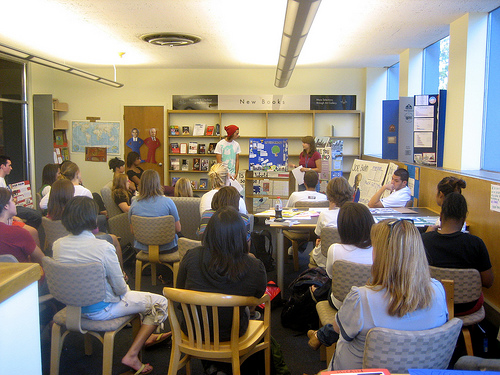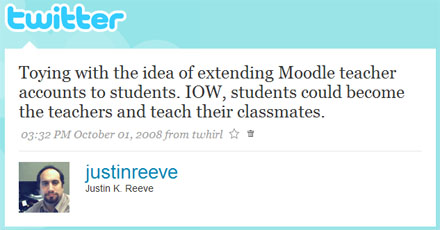Posts tagged teacher
Building a Better Teacher
0I just came across this article from the New York Times and thought it was rather good. I’m including the Diigo annotated link rather than the original link, because I thought that some of the other user comments from teachers were quite good, too: http://diigo.com/09xux. Click the speech bubble icons near the highlighted text scattered throughout the article to view these comments.
I like the story (p. 6-7) about the elementary student who started a debate over odd and even numbers, suggesting that a number can be both. Rather than immediately correcting the misunderstanding, the teacher allowed the students to discuss this basic of math for themselves, devise their own definition of “even and odd” through experimenting with adding different types of numbers, and reach their own conclusions. The end result was an improvised spontaneous lesson the students directed themselves.
References
Green, E. (2010, March 7). Building a better teacher. The New York Times. Retrieved from http://www.nytimes.com/2010/03/07/magazine/07Teachers-t.html
Turning Students Into Teachers with Moodle
8I’ve noticed a few differences in how our teachers and students use Moodle. The details may vary, but in general a teacher will log in, maybe upload a PowerPoint document, and if they’re adventurous they’ll set up an online quiz, and possibly a forum.
A student, on the other hand, logs in, and explores everything. One of the first things they’ll notice is their Profile page. They’ll edit their profile, upload a photo of themselves, and may even get creative and embed a cool Flash widget they like. Then they’ll pop into the class forum and post a message. They will return to this forum a few times throughout the day to continue talking to their classmates. They will then download the teacher’s course material, study it, and take the teacher’s quiz that’s been set up. They may then return to the forum to see if anyone responded to their messages, and maybe post another message to someone else, before uploading their daily homework assignment.
 See a pattern here? Students are the power users. The technology is familiar to our “digital natives,” and they enjoy using it. Some of our students have even panicked when the technology wasn’t available. Once our Moodle server went down for a reboot, and was offline only about 2 minutes when I received an IM from a teacher. She said the students were freaking out and asking “When will Moodle be back up?”
See a pattern here? Students are the power users. The technology is familiar to our “digital natives,” and they enjoy using it. Some of our students have even panicked when the technology wasn’t available. Once our Moodle server went down for a reboot, and was offline only about 2 minutes when I received an IM from a teacher. She said the students were freaking out and asking “When will Moodle be back up?”
So I had a thought the other day:
Teachers can manage classes in Moodle, but why not students? People often learn best when they teach, and it seems like we’re only targeting half our potential audience here. We could turn the students into teachers, and let them teach their classmates. It would be a great way to create effective learners.
A teacher could use this as a classroom activity. They could assign students to “teach” a particular topic they’re studying in class, and the student could create video presentations, quizzes, wikis, and other course material in their own Moodle course. They will become better learners through teaching, and we will be preparing them for college by introducing them to their online classroom space.
Not Just for In-Class
 But online student-teaching could extend beyond the classroom as well. Under the sponsorship and mentoring of a teacher, a student could teach about any subject that interests them, whether it be athletics, books, auto repair, video games, woodworking, painting, animation, music, and more. Imagine a whole network of students teaching about a diverse range of topics. Other students could browse the available courses their peers are instructing, enroll, and contribute to a system where student interests and knowledge are shared in a constructive, educational manner. Moodle could become the focal point of a vibrant student learning network.
But online student-teaching could extend beyond the classroom as well. Under the sponsorship and mentoring of a teacher, a student could teach about any subject that interests them, whether it be athletics, books, auto repair, video games, woodworking, painting, animation, music, and more. Imagine a whole network of students teaching about a diverse range of topics. Other students could browse the available courses their peers are instructing, enroll, and contribute to a system where student interests and knowledge are shared in a constructive, educational manner. Moodle could become the focal point of a vibrant student learning network.
A rewards system may provide an added incentive to this “Young Teachers” program. Example: for every student that signs up for a course, the student-teacher earns points. If enrollees pass the course by taking an exam, the student-teacher earns even more points. Those who pass a student-made course could earn “attendee points” and receive certificates for passing. At the end of the year, we could give out prizes for those who’ve earned the most points, or hold an awards ceremony to recognize the best student-teachers.
With the right motivation, we would have no problem finding students interested in teaching their own classes.
Is This Really “Educational?”
The very nature of having students teaching courses is educational, because we’d be placing them in managerial roles as they organize their online classrooms. They would set up their course how they want, determine the best method of teaching and presenting the material, and create quizzes to make sure the other students understand what they are teaching. They could even organize activities through their online classroom. For example, a student teaching a class on theatre arts could set up a date to have everyone attend a local play. A student teaching a class on poetry could set up an online chat session with an English professor his family knows. There are numerous possibilities here.
At the same time, some questions need to be asked. Since this may be extracurricular for students, do we need to worry about keeping all student-taught courses within the state core curriculum? Also, it might not really be considered “educational” to let students teach a class on, e.g., video games, and just discuss strategies for Halo 3, when they could be teaching concepts of video game design and providing helpful tutorials and tools for independent game development. Clear goals should be outlined and standards set forth, so the teacher mentors can guide the students toward education-appropriate courses.
Benefits
- Students would become more actively involved in the educational process, both on the receiving and giving end.
- We would be preparing students for college by promoting self-directed learning, and introducing them to the online class environment.
- Studies have shown that online learning opportunities can encourage even the normally reticent students to participate in class.
- The beginnings of a student learning network would be created.
- Students would develop organizational leadership skills.
- Students would earn the recognition of their teachers, parents, and peers.
- Students would find it motivating and empowering to maintain their own online classroom about a subject that interests them.
- Students would have a valuable portfolio of their work.
- Parents could visit their student’s course and follow the progress.
Teacher Mentors
Each school could have one or two teacher mentors for these student-created courses. They would be responsible for the following:
- Hearing and approving student course requests.
- Creating the student course in Moodle.
- Making sure students understand the rules for their course, such as appropriate behavior (no offensive material or language) and resources they can use, breadth requirements for the “passing” exam, etc.
- Being available for questions about appropriate course material and helping students with extracurricular activity planning if necessary.
- Periodically checking up on the students’ courses.
Breaking Out of the Shell
0I received an email from one of our teachers a few days ago, expressing concerns over someone outside our district who linked to her blog. This isn’t the first time I’ve received an email like this, so with her permission, I’m posting her email here, followed by my long-winded reply with more information than she probably wanted to know. I hope this provides some clarity to our teachers who may have similar concerns:
Hi – I had something interesting happen on my blog today. I received an e-mail to moderate. The post left was from a student in Alabama that had come across my blog while doing some research for her class. It had me a bit concerned because I thought I had blocked my blog from this? Should I be concerned? She gave me a link to her blog and on her blog she had posted a link back to mine. I am not sure how I feel about that? What should I do? Thanks.
Whether this is good or bad really depends on your point of view. Here’s my two cents. Note that what I say here is just my opinion, and doesn’t represent any official district view, but I hope it provides some perspective.
Keep in mind that the blogs are public, not private. They’ve always been accessible to everyone on the web, and there’s nothing you can really “block” your blog from. Maybe you don’t post links to your blog on all sorts of web sites, but you still don’t have full control over how much it’s publicized. You can password-protect your posts if you want to, but I think that would be missing the point of the blog’s purpose: connectedness and communication. Google indexes your blog so anyone can search it, and we list the latest posts and blog rankings on our district site. We actually do this so people CAN be made more aware of your blog. It’s open to everyone, and it’s a fantastic way to communicate with your students and their parents, and let them communicate with you in turn by leaving comments. Sometimes parents may share your blog with their family and friends, and they in turn may share it with others.
But the blogs can do more than connect you with just your own students and parents. They can also break down the walls of the classroom and connect you to an online learning community, as this student from Alabama demonstrated. I don’t know exactly what this student put in her comment, but she apparently found something very useful on your blog, and liked it enough to not just leave a comment, but link to your blog from her own. That’s a compliment to you. This student’s link will drive more visitors to your blog, and your ranking on the “Visitors per Day” stat will go up.
And if you want to take it further, by following the links your commenters leave, you may find yourself drawn to more sites such as other class blogs, Ning networks, Facebook groups, wikis, Twitter, or wherever educators are gathering on the web. In fact, this is what I’ve found most enjoyable with my own blog, that I can connect with a wide range of people. Most of my visitors aren’t even from within the district; they’re teachers, technology specialists, and school administrators from all over the world. I’ve even been able to meet a few of them face-to-face after connecting with them online. My blog can be a catalyst for stimulating wider conversations and growing my own personal learning network of educators.
There are also teachers out there who are engaged in activities like the Flat Classroom Project – they use wikis and learning networks to synchronize two or more classrooms, and let students from all across the world work with each other on projects. I’ve seen Kindergarten class blogs that have a YackPack button, which lets students and teachers from other classes just click and start talking with the classroom. And here’s some elementary students using Skype to video conference with other students several states away, and doing a collaborative writing project with them in Google Docs, while the teachers and administrators are standing by in amazement. It IS very cool, because it shows you’re not confined to the walls of your classroom anymore.
So my opinion is that this student linking to your blog is a GOOD thing, because it’s just one step to opening you to a larger learning community. And if all this leaves you feeling paranoid, don’t let it! Other teachers are going through many of the same experiences you are, regardless of where they come from, and you can connect with them as well. We want you to have fun with your blog. Be creative with it, and share your classroom experiences, fun activities you do with your students, and more. If other teachers and students outside your class are visiting your blog, that’s just an added bonus.
I also recommend you activate the WP-Slimstat plugin (go to your blog Dashboard, click “Plugins” and then “Activate” next to WP-Slimstat). This will start to gather more detailed statistics on exactly how many people are visiting your blog, what search strings are being used to find your blog, your most popular posts and pages, and so on. If you want some assistance accessing and analyzing all these statistics, let me know.
I hope this helps add a little insight on the wide scope of the blogs. There’s a giant online world out there of online networking and collaboration. Our students are using it already. Perhaps it’s time we start using it, too.
Thanks for the question.

